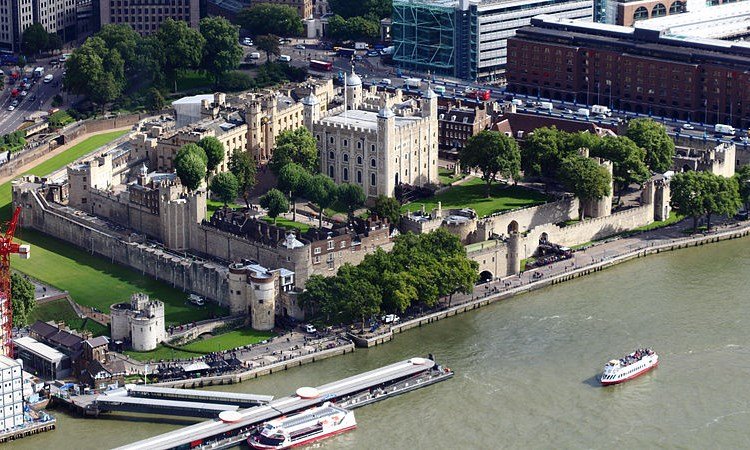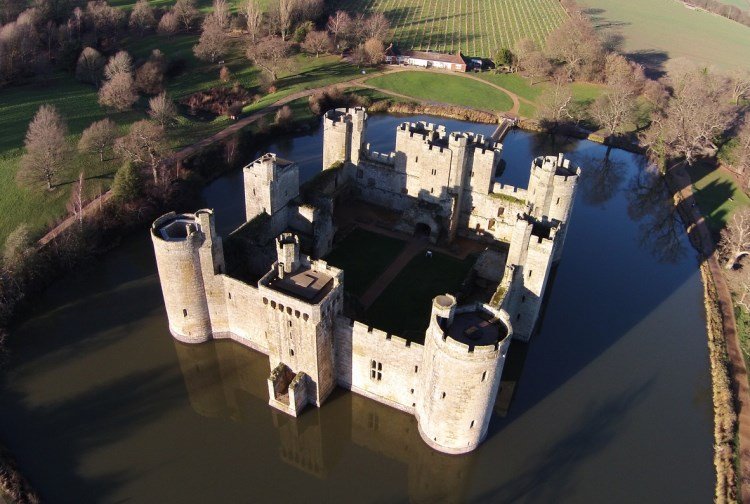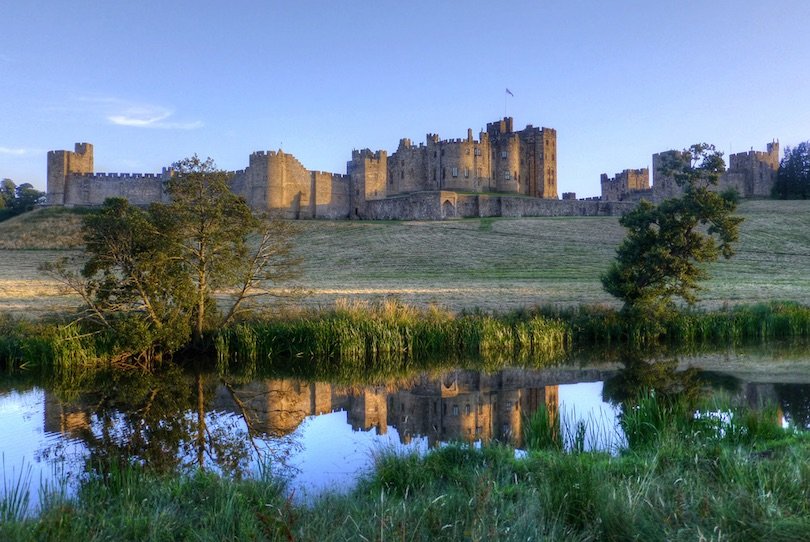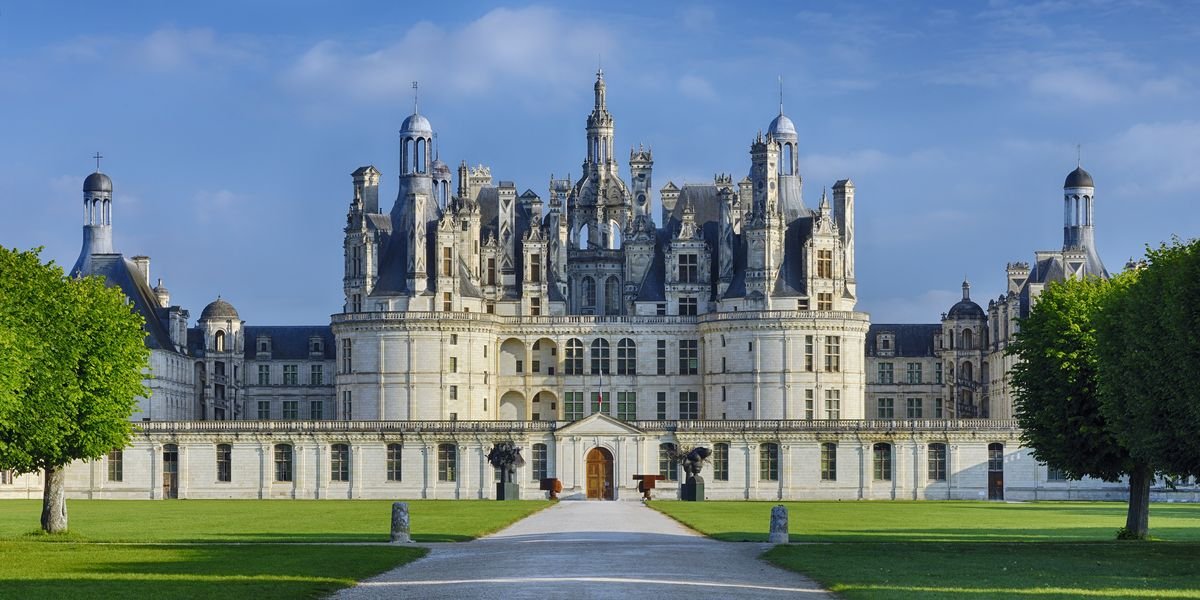10 Most Beautiful Castles in England‘s castles were initially created with the purpose of safeguarding those inside while keeping enemies at bay. These remarkable structures have captivated travelers from around the world for centuries. The concept of castles in Britain originated during the Norman Conquest in the 11th century and continued to be constructed until the 18th century. While the earlier castles were primarily used for defense, the ones built later on were more focused on showcasing wealth and grandeur rather than practical fortification.
Today, there are numerous castles in England undergoing restoration or falling into decay. Many of these castles have become popular tourist destinations, offering visitors a glimpse into the reality of castle life beyond the enchanting tales of towers, turrets, and hidden treasures.
Leeds Castle [SEE MAP]
 Leeds Castle, situated in Kent, England, is a magnificent and well-preserved castle that embodies the quintessential image of an English castle. Constructed during the reign of Henry I, this castle has served as a royal residence for over 900 years.
Leeds Castle, situated in Kent, England, is a magnificent and well-preserved castle that embodies the quintessential image of an English castle. Constructed during the reign of Henry I, this castle has served as a royal residence for over 900 years.
Throughout its rich history, it has been home to six queens, earning it the endearing nickname of “The Ladies Castle.” Notably, the castle’s final private owner, Olive Wilson Filmer, Lady Baillie, inherited the estate in the early 1900s. Following her passing in 1974, the castle has been managed by a foundation and transformed into a popular tourist destination.
Spanning across a vast 500-acre estate, Leeds Castle offers an array of attractions that cannot be fully explored in a single visit. The castle is surrounded by a wide moat, which is actually a lake fed by the River Len. Punting on the tranquil waters of the moat is a beloved activity for visitors. Additionally, the castle grounds feature a splendid yew maze and a turf maze designed specifically for young children. With its opulent palace and picturesque surroundings, Leeds Castle truly encapsulates the allure of an English castle.
Arundel Castle
Arundel Castle, situated in West Sussex in the southern part of England, serves as the seat of the Duke of Norfolk. It is renowned as one of the finest castles in England that has been continuously inhabited. The castle boasts a well-preserved interior adorned with rare paintings, tapestries, and furnishings. Its most ancient element is the motte, an earthwork mound that elevates the castle to a height of 30 meters (100 feet) above the now-dry moat.
For over 850 years, Arundel Castle has remained the residence of the Dukes of Norfolk and their predecessors. Although it suffered significant damage during the English Civil War in the 17th century, the castle has undergone numerous renovations throughout the centuries. In the 19th century, the 15th Duke of Norfolk successfully completed an extensive restoration project. Presently, the castle welcomes the public to explore its remarkable rooms, including the estate’s 14th-century chapel and its stunning gardens.
Bamburgh Castle
 Located on the coastline of Northumberland, England, Bamburgh Castle is situated on a volcanic outcrop of stone. Its origins can be traced back to the 3rd or 4th century, possibly serving as the capital of the kingdom ruled by the native Britons known as Din Guarie. The main structure of the castle was constructed by the Normans in the 11th century, with the belief that Henry II commissioned the building of the castle keep.
Located on the coastline of Northumberland, England, Bamburgh Castle is situated on a volcanic outcrop of stone. Its origins can be traced back to the 3rd or 4th century, possibly serving as the capital of the kingdom ruled by the native Britons known as Din Guarie. The main structure of the castle was constructed by the Normans in the 11th century, with the belief that Henry II commissioned the building of the castle keep.
In 1894, the castle was purchased and restored by Victorian industrialist William Armstrong. Presently, it remains the residence of the Armstrong family, with 16 rooms accessible to visitors. Some of these rooms have been transformed into exhibition halls, showcasing artifacts such as Medieval armor. Notably, the renowned Bamburgh Sword from the 7th century was excavated from the site during an archaeological dig.
Tower of London
 wikipedia/Rafa Esteve
wikipedia/Rafa Esteve
Construction of the Tower of London commenced in 1066 along the northern bank of the River Thames. Despite being initially built as a fortified castle and royal residence, it predominantly served as a prison from 1100 to 1952. Notable figures from English history, including Richard II, Henry VI, Edward V, and Elizabeth I, were incarcerated within its formidable walls. Additionally, two of Henry VIII’s six wives met their tragic fate on the Tower Green, where they were beheaded.
Although officially known as Her Majesty’s Royal Palace and Fortress, the Tower has not been utilized as a residence by the royal family since the Tudor era. Since then, it has become a renowned tourist attraction, captivating visitors with its menagerie, captivating displays of armory, and the nation’s esteemed Crown Jewels. The highlight of a visit to the Tower of London is undoubtedly the Yeoman Warder tours, led by knowledgeable, friendly, and talkative “Beefeaters.”
Warwick Castle

Warwick Castle, constructed by William the Conqueror in 1068, stands proudly on a bend of the River Avon. Over the centuries, this magnificent castle has witnessed numerous structural modifications, including the addition of towers and the redesigning of residential buildings.
Originally made of wood, it was later reconstructed using stone in the 12th century. During the tumultuous Hundred Years War, the side facing the town was fortified, resulting in an iconic example of 14th-century military architecture. Serving as a stronghold until the early 17th century, Warwick Castle was eventually transformed into a country house by Sir Fulke Greville. The Greville family held ownership of the castle until 1978, when it was acquired by a leisure company.
Bodiam Castle
 Situated in East Sussex, southeast of London, Bodiam Castle is renowned as an exemplary Medieval fortress, although its construction in the 14th century primarily aimed at showcasing prestige rather than fortification. Following the conclusion of the 100 Years’ War, Sir Edward Dalyngigge, a veteran soldier and landowner, received permission from Richard II to fortify his residence as a precautionary measure against potential French invasions.
Situated in East Sussex, southeast of London, Bodiam Castle is renowned as an exemplary Medieval fortress, although its construction in the 14th century primarily aimed at showcasing prestige rather than fortification. Following the conclusion of the 100 Years’ War, Sir Edward Dalyngigge, a veteran soldier and landowner, received permission from Richard II to fortify his residence as a precautionary measure against potential French invasions.
Bodiam Castle possesses all the enchanting features that one would anticipate when exploring a Medieval castle, including towering turrets, defensive battlements, an imposing portcullis, and a surrounding moat. Regrettably, the castle’s interior lies in ruins, having been dismantled during the English Civil War in the 1600s to prevent its utilization by adversaries. In 1829, the castle was acquired by art philanthropist John Fuller for the sum of 3,000 guineas, thereby rescuing it from imminent demolition.
Windsor Castle[SEE MAP]
 Windsor Castle, often referred to as the largest and oldest inhabited castle globally, is situated approximately one hour west of London. It serves as one of the official residences of Queen Elizabeth II, who frequently spends her weekends at the castle for both state and private functions. The earliest surviving structures at Windsor date back to the reign of Henry II, who ascended to the throne in 1154.
Windsor Castle, often referred to as the largest and oldest inhabited castle globally, is situated approximately one hour west of London. It serves as one of the official residences of Queen Elizabeth II, who frequently spends her weekends at the castle for both state and private functions. The earliest surviving structures at Windsor date back to the reign of Henry II, who ascended to the throne in 1154.
Originally constructed as a motte and bailey castle to safeguard Norman dominance in the outskirts of London, Windsor Castle consisted of three wards surrounding a central mound. Over time, the castle underwent transformations, replacing its original materials with stone fortifications. It successfully endured a prolonged siege during the First Barons’ War in the early 13th century.
Throughout the Tudor era, both Henry VIII and Elizabeth I utilized the castle extensively as a royal court and a hub for diplomatic entertainment. Presently, visitors have the opportunity to explore various parts of the castle, including the magnificent State Apartments and St George’s Chapel.
Corfe Castle
 Situated on a hill close to the picturesque village of Corfe in Dorset, the remains of Corfe Castle can be traced back to the 11th and 12th centuries. This castle, boasting an imposing limestone keep that stands at an impressive height of 20 meters (70 feet), was strategically constructed to discourage potential invaders.
Situated on a hill close to the picturesque village of Corfe in Dorset, the remains of Corfe Castle can be traced back to the 11th and 12th centuries. This castle, boasting an imposing limestone keep that stands at an impressive height of 20 meters (70 feet), was strategically constructed to discourage potential invaders.
It is worth mentioning that Lady Bankes fearlessly defended the castle for a period of three years during the English Civil War, even resorting to dropping hot coals on Parliamentary soldiers in the final assault. After its capture, the inner keep of Corfe Castle, like numerous other castles in England, was deliberately dismantled to prevent any future use by Royalist forces. To this day, visitors can still observe arrow slits and murder holes within the castle’s captivating ruins.
Alnwick Castle is one of the 10 Most Beautiful Castles in England
 Alnwick Castle, the residence of the Duke of Northumberland, holds the distinction of being the second largest inhabited castle in England, surpassed only by Windsor Castle, which is the preferred weekend retreat of the Queen. Constructed in the 11th century, Alnwick Castle has remained in the possession of the Percy family for an impressive span of 700 years. While the current Duke and Duchess continue to reside in a portion of the castle, the majority of it is accessible to the public for seven months each year.
Alnwick Castle, the residence of the Duke of Northumberland, holds the distinction of being the second largest inhabited castle in England, surpassed only by Windsor Castle, which is the preferred weekend retreat of the Queen. Constructed in the 11th century, Alnwick Castle has remained in the possession of the Percy family for an impressive span of 700 years. While the current Duke and Duchess continue to reside in a portion of the castle, the majority of it is accessible to the public for seven months each year.
Throughout its extensive history, Alnwick Castle has undergone numerous renovations, revamps, and refurbishments. Within its walls, visitors are treated to a magnificent display of artwork, boasting one of England’s most exceptional collections of paintings, including masterpieces by renowned artists such as Titian, Reynolds, and Gainsborough. Notably, the castle’s striking exterior has graced the silver screen in various films and famously served as the backdrop for the Hogwarts school in the beloved Harry Potter movies.
Framlingham Castle
 Situated in Suffolk, England’s eastern region, Framlingham Castle exemplifies the traditional fortifications known as “motte and bailey” that were prevalent in the 11th and 12th centuries. The term “bailey” refers to the protective outer wall surrounding the castle, while “motte” denotes the elevated earthwork on which the castle stands. Presently, the stockade and its 13 towers entice visitors who wish to stroll along the castle wall.
Situated in Suffolk, England’s eastern region, Framlingham Castle exemplifies the traditional fortifications known as “motte and bailey” that were prevalent in the 11th and 12th centuries. The term “bailey” refers to the protective outer wall surrounding the castle, while “motte” denotes the elevated earthwork on which the castle stands. Presently, the stockade and its 13 towers entice visitors who wish to stroll along the castle wall.
During the Tudor Period, Framlingham Castle played a significant role in history as it was owned by the Howard family. The estate was seized by Henry VIII, returned by Queen Mary, and once again taken back by Elizabeth I. Following her demise, the castle was returned to the Howards once more. In 1636, Pembroke College received the castle as a donation, leading to the demolition of the inner structures to construct a poorhouse. Visitors can delve into the castle’s history at the “From Powerhouse to Poorhouse” exhibition and also witness the Howard family tombs at the nearby Saint Michael Church.






